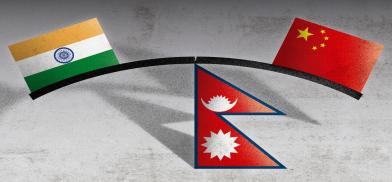After India-China thaw, Beijing draws Nepal in strategic embrace
Oli is scheduled to China after November 15. The primary discussion will likely be on speeding up the BRI as well as economic cooperation between the two nations. Beijing will do its best to draw Nepal deeper into its strategic sphere and further a joint approach in dealing with India to further China’s national interests.

The recent defrosting in India-China relations, through what India calls “agreement” and China terms “resolutions”, primarily pertains to resumption of Indian troops patrolling their own territory in eastern Ladakh. The Chinese media says the arrangement is based on “existing ground situation”. The Indian Army points out the need is to build “trust”. Ambiguity prevails ed (https://m.rediff.com/news/column/modi-xi-agreement-the-nation-needs-to-know/20241028.htm); given that the signed agreement/resolutions document is not made public by the government, as demanded by Subramanian Swamy, former Member of Parliament belonging to India’s ruling party.
The media is full of cover about “disengagement” in Depsang and Demchok in eastern Ladakh – similar to when the buffer zone was created along the north bank of Pangong Tso, after China forced India to vacate the Kailash Range, including our posts overlooking PLA’s Moldo garrison. Patrolling in Depsang up to which LAC remains the major question among many others (https://www.indiandefensenews.in/2024/11/post-india-china-disengagement.html?m=1), while China is constructing a dual-use military village bang on the LAC in Demchok. The PLA will unlikely dismantle permanent structures it erected in 2020, while reverting to the pre-April 2020 posture is out of the question.
However, the propaganda about disengagement even shows PLA troops pullout from areas not anywhere close to the LAC (https://x.com/jenniferzeng97/status/1850918852693033027?t=ZubPjiiXphyLvCWaua5loA&s=08), causing mirth amid speculation whether China is also vacating Aksai Chin fearing India. Defence Minister Rajnath Singh, who kept chanting over the past four years “not even one inch of territory lost”, announced on October 31 that disengagement has been completed. But the Chinese government and media are conspicuously silent on the issue.
Inciting Delhi-Kathmandu tensions
Significantly. while the patrolling/disengagement was being put in motion, news came that Nepal has contracted a Chinese company, China Banknote Printing and Minting Corporation, to print 300 million 100-rupee currency notes; at a cost of over NPR 1.2 billion (about USD 8.98 million), with each note costing around NPR 4.04. Significantly, these notes will feature an updated political map of Nepal that includes the Indian areas of Limpiyadhura, Lipulekh, and Kalapani. This will heighten tensions between New Delhi and Kathmandu. But its timing suggests Prime Minister KP Sharma Oli-led Nepal took this decision in consultation with Beijing to relay a signal to India on China’s behalf.
Nepal has been in China’s crosshairs since the Mao Zedong era when Beijing initiated Maoist insurgency in Nepal as a long-term strategic move, eventually leading to communist rule in Nepal intermittently or with communist support. Oli and Puspa Kamal Dahal (called Prachanda) have been China’s blue-eyed boys from the insurgency days – with both holding the appointment of Nepal’s prime minister thrice, including Oli’s present term. Even before Prachanda became prime minister for the first time, he told Nepalese: “Our ultimate fight will be with the Indian Army”. Prachanda has always been accorded a red carpet when visiting Beijing, even when he was not Nepal’s prime minister.
During Oli’s visit to Beijing in March 2016, Nepal and China signed the Transit and Transport Agreement (TTA) to access China from six checkpoints; it was Nepal which sought access to the Chinese ports. Nepal took this step because of the prolonged blockade of the India-Nepal border during 2015-2016, causing severe fuel and medicine shortages for months – brainchild of National Security Adviser Ajit Doval playing ‘big brother’ despite hyping “Neighbours First”.
Nepal joined China’s Belt and Road Initiative in 2017. In June 2020, Oli-led Nepalese Parliament passed a new map showing Lipulekh, Kalapani and all areas north of the river Kuthi Yangti up to its source at Limpiyadhura on the main Himalayan watershed (totaling about 370 sq km) in its territory. These areas fall in Pithoragarh district of Uttarakhand and India holds posts in Kalapani since 1962, but Nepal claims the British gave this area to Nepal in 1816 by the Treaty of Saguali. The Indian map released in October 2019 showing reorganized Jammu & Kashmir drew adverse comments from China and Pakistan, egging Oli to claim the above-mentioned three areas of India.
Pakistan' strategic inroads in Nepal
The Indian government’s decision to stop regular recruitment in the army broke the decades-old bond between the armies of India and Nepal, denying some 1,300 Nepalese Gorkhas service in the Indian Army as regulars. China, which already has Tibetans in the PLA, is keen to recruit Nepalese soldiers (https://www.eurasiantimes.com/china-keen-to-recruit-gurkha-soldiers-into-pla-will-it-become/?amp). Whenever Kathmandu came under communist rule, Pakistan’s ISI made bigger inroads in Nepal. Now Nepalese officers are being trained in the Pakistan Military Academy. Nepal permitted China oil drilling in the Terai region bordering India and 30 Chinese NGOs to penetrate Nepal’s social sector.
Oli is scheduled to China after November 15. The primary discussion will likely be on speeding up the BRI as well as economic cooperation between the two nations. Beijing will do its best to draw Nepal deeper into its strategic sphere and further a joint approach in dealing with India to further China’s national interests. Oli’s exhortations of balancing ties between India and China, and that Nepal does not allow its territory to be used against either neighbour, must be taken with a pinch of salt as Oli has been China’s protégé for decades.
(The author is an Indian Army veteran. Views expressed are personal)










Post a Comment